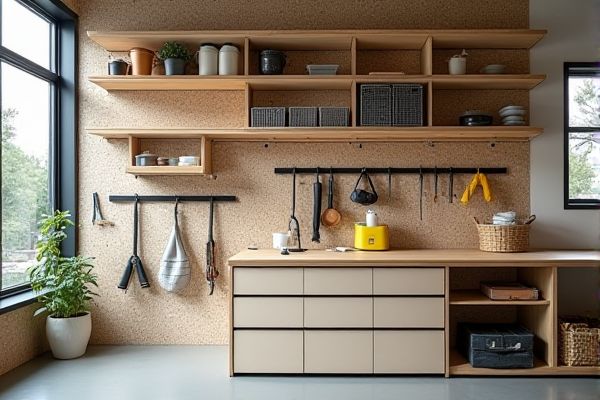
Pegboard storage offers versatile and customizable solutions ideal for organizing small tools and accessories, while slatwall storage provides a sleek, durable option capable of supporting heavier items with adjustable hooks and shelves. Explore the article to discover which storage option best suits your space and organizational needs.
Table of Comparison
| Feature | Pegboard Storage | Slatwall Storage |
|---|---|---|
| Material | Usually metal or wood with evenly spaced holes | Wood, MDF, or metal panels with horizontal grooves |
| Installation | Easy to install, often lightweight | Requires sturdy wall support and precise mounting |
| Customization | Flexible with a wide variety of hooks and accessories | Highly customizable with slat inserts and specialized accessories |
| Load Capacity | Moderate; suited for lighter tools and items | High; can hold heavier tools and equipment securely |
| Durability | Less durable, prone to bending if overloaded | More durable and robust for heavy-duty use |
| Visual Appeal | Simple, utilitarian look | Sleek and professional appearance |
| Cost | Generally more affordable | Tends to be more expensive |
| Best Use Case | DIY projects, home garages with light to medium tools | Professional workshops, retail displays, heavy tools storage |
Introduction to Pegboard and Slatwall Storage
Pegboard storage consists of perforated panels with evenly spaced holes designed to hold hooks, shelves, and accessories, making it ideal for organizing small tools and lightweight items. Slatwall storage features horizontal grooves or slats that accommodate specialized hooks, bins, and shelves, providing a versatile solution for heavier and bulkier objects. Both systems optimize vertical space in garages, workshops, and retail environments by maximizing accessibility and customization options.
Key Features of Pegboard Storage Systems
Pegboard storage systems feature perforated panels with evenly spaced holes that allow for versatile hook and accessory placement, making them ideal for organizing tools and small items. Their lightweight design and ease of installation on walls or workbenches provide flexible customization for your workspace. Pegboards offer quick access and efficient use of vertical space, enhancing organization in garages, workshops, and craft rooms.
Key Features of Slatwall Storage Systems
Slatwall storage systems feature horizontal grooves designed to accommodate a wide range of hooks, shelves, and baskets, offering versatile and customizable organization solutions. Made from durable materials like MDF, PVC, or metal, slatwall panels provide strong support for heavy tools and equipment, making them ideal for garages and retail spaces. Their modular design allows easy rearrangement and expansion, maximizing storage efficiency while maintaining a clean, streamlined appearance.
Space Utilization: Pegboard vs Slatwall
Pegboard storage offers efficient space utilization by allowing you to customize hook placement for small tools and accessories, maximizing vertical wall space. Slatwall storage provides greater versatility with adjustable accessories like shelves and bins, enabling better accommodation of bulkier items and optimizing overall storage capacity. Choosing between pegboard and slatwall depends on the specific organization needs and the types of items you plan to store.
Installation Process: Pegboard vs Slatwall
Pegboard storage offers a straightforward installation process, typically requiring only screws to mount the board directly onto wall studs or drywall anchors, making it accessible for DIY enthusiasts. Slatwall storage installation is more complex, involving mounting horizontal panels securely to wall studs, often requiring precise alignment and heavier-duty hardware to support adjustable accessories. Both systems demand consideration of wall material and stud spacing, but pegboards are generally quicker to install, while slatwalls provide more structural strength for heavier storage needs.
Customization and Accessory Options
Pegboard storage offers a wide range of customization through easily adjustable hooks, bins, and shelves, enabling versatile arrangements for various tools and accessories. Slatwall storage provides extensive accessory options including specialized hooks, baskets, and cabinets that securely fit into the horizontal grooves, allowing for organized and scalable storage solutions. Both systems optimize space but pegboards excel in quick rearrangement, while slatwalls support heavier loads with more structural accessories.
Durability and Maintenance Comparison
Pegboard storage offers moderate durability with its perforated hardboard material, which can withstand regular tool hanging but may warp or chip over time if exposed to moisture. Slatwall storage, made from MDF or PVC panels with horizontal grooves, provides superior durability and resistance to wear, scratches, and moisture, making it ideal for heavy-duty or humid environments. You will find slatwall systems require less maintenance due to their robust construction and easier cleaning compared to pegboards.
Cost Analysis: Pegboard vs Slatwall
Pegboard storage typically costs less upfront, averaging $10 to $30 per panel, making it a budget-friendly option for organizing tools and small items. Slatwall storage, with prices ranging from $20 to $60 per panel, involves higher material and installation expenses but offers enhanced durability and customization options. Considering long-term value, slatwall's robust design supports heavier loads and versatile accessory compatibility, potentially reducing replacement and upgrade costs over time.
Best Uses and Ideal Environments
Pegboard storage excels in versatile, lightweight organization for garages, workshops, and craft rooms, ideal for holding small tools, accessories, and frequently used items due to its easy customization with hooks and bins. Slatwall storage suits retail environments, garages, and industrial spaces that require heavy-duty support and display flexibility, efficiently accommodating shelves, baskets, and hangers for larger or heavier items. Pegboards offer cost-effective, low-profile solutions for casual or hobbyist use, whereas slatwalls provide robust, professional-grade storage for high-traffic, weight-intensive applications.
Conclusion: Choosing the Right Storage Solution
Pegboard storage offers flexibility for organizing small tools and accessories with customizable hooks and holders, making it ideal for workshops or craft rooms where quick access is essential. Slatwall storage provides a more robust and visually appealing option, supporting heavier items and a wider variety of attachments suited for retail displays or garages. Your choice depends on the weight and type of items you need to store, as well as the desired aesthetic and installation space.
 homyna.com
homyna.com